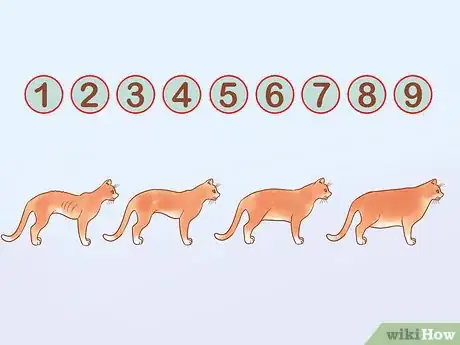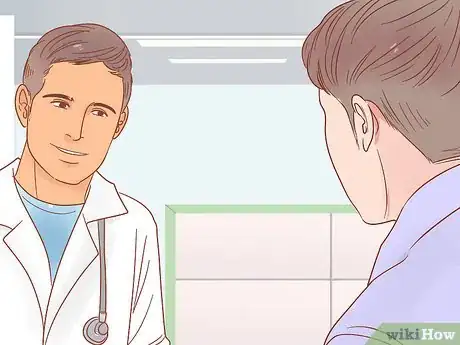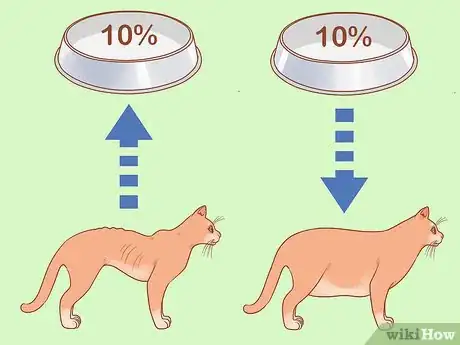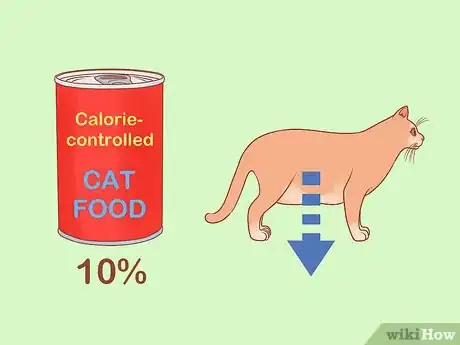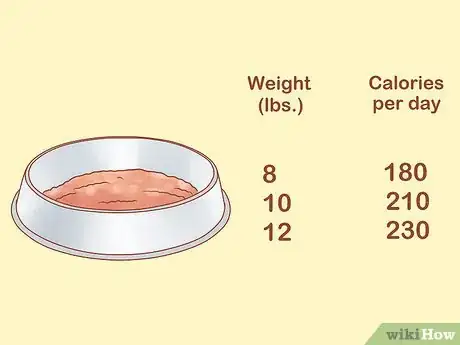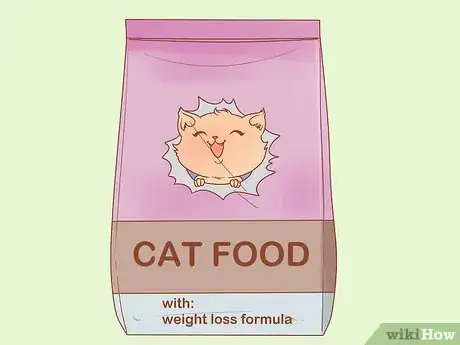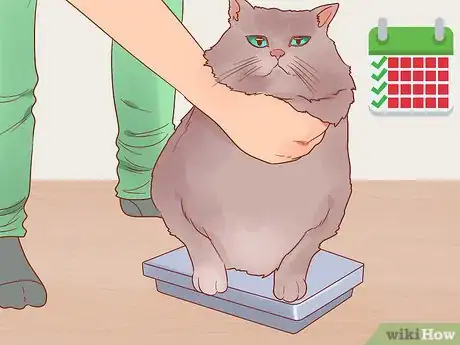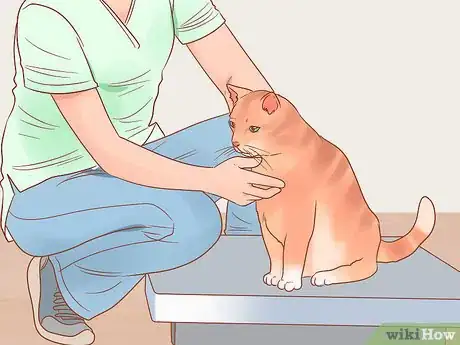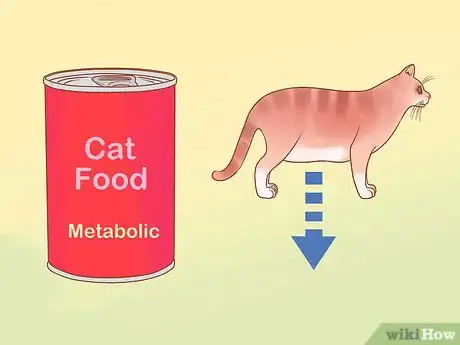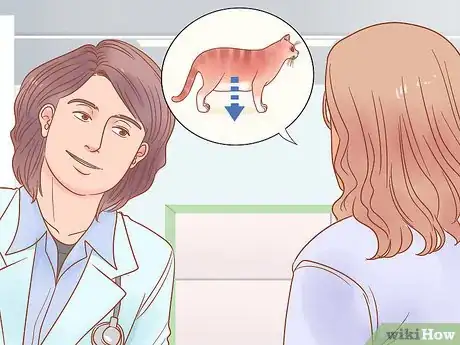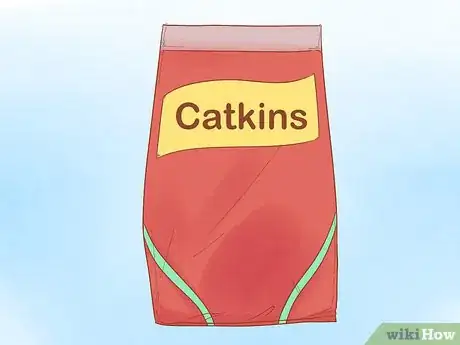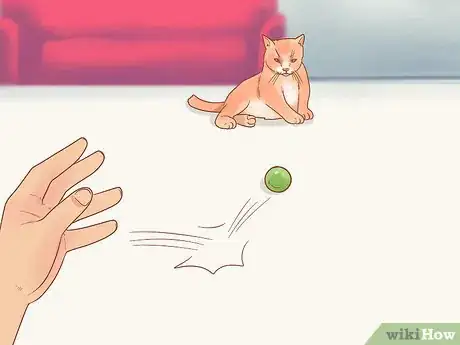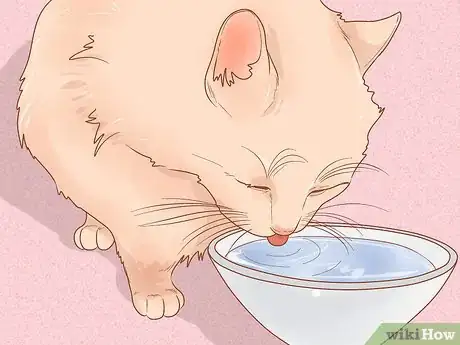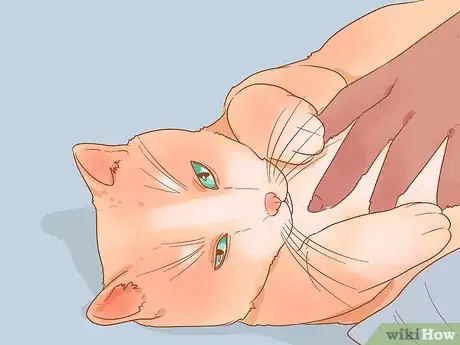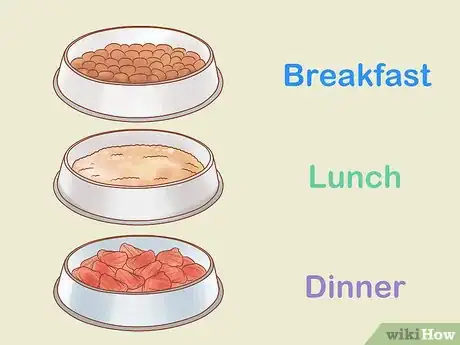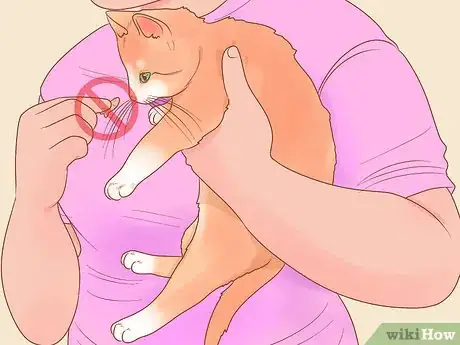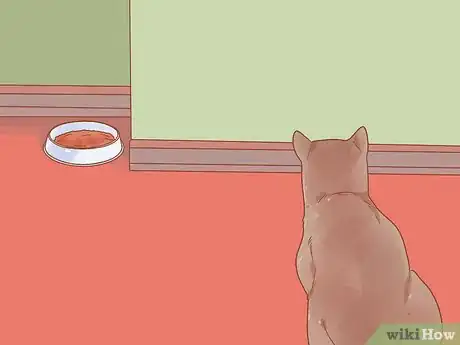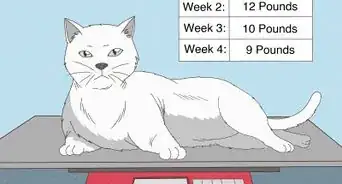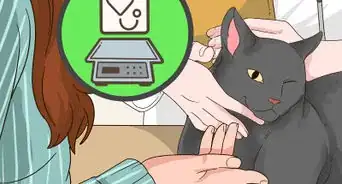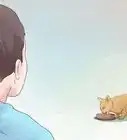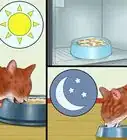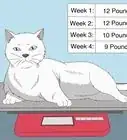This article was co-authored by Pippa Elliott, MRCVS. Dr. Elliott, BVMS, MRCVS is a veterinarian with over 30 years of experience in veterinary surgery and companion animal practice. She graduated from the University of Glasgow in 1987 with a degree in veterinary medicine and surgery. She has worked at the same animal clinic in her hometown for over 20 years.
There are 11 references cited in this article, which can be found at the bottom of the page.
This article has been viewed 59,169 times.
Obesity is not just something that people struggle with, it is a challenge for cats as well. Unfortunately, obesity is strongly linked to poor health in cats, especially increasing the risks of liver disease and diabetes mellitus (sugar diabetes).[1] With high-calorie foods easily available for a bored cat to indulge in—not to mention less need for a house cat to exercise or use her hunting instincts—it’s little wonder that a large percentage of pet cats are now little couch potatoes.[2] Luckily, there are ways that you can help your cat to lose weight, including putting her on a restricted diet.
Steps
Determining If Your Cat Needs to Lose Weight
-
1Do a body condition score. Before you put your cat on a diet, it’s important to determine whether or not your cat really needs to lose weight. A body condition score consists of a scale from one to five—with five being obese and one being emaciated. An ideal score is three. Rate your cat on the scale according to the following standards:
- Score 1: Ribs, spine, and pelvis stick out and can be seen even at a distance. The cat has no body fat and looks starved and bony.
- Score 2: Ribs, spine, and pelvis can be easily felt. Viewed from above, the cat has a distinct waist. Viewed from the side, the belly is tucked up. The cat looks thin.
- Score 3: Ribs and spine can be felt but not seen. The cat has a slight waist when viewed from above, and a level (but not saggy) tummy from the side. Ideal.
- Score 4: Ribs and spine difficult to locate. Pear-shaped tummy from above and sagging down from the side. Can be described as chunky or stout.
- Score 5: Bony landmarks obscured by fat. Thick cover of fat over chest and tummy. Oval silhouette. Obese.
-
2Visit the vet. If your cat’s body condition rates as a four or five, then see your veterinarian for more guidance. Your veterinarian will have tools to determine the target weight for your cat based on your cat’s exact size, using a series of measurements such as the length of your cat’s head, width of head, backbone length, radius of the wrist, and girth measurement.[3]
- The visit to the vet is equally important because your vet will perform a physical exam of your cat to ensure that simple overeating is the cause of your cat’s weight problem and not a more serious medical condition.
Advertisement -
3Discuss a variety of options. Several methods are available to help your cat lose weight. When your veterinarian sets a target weight for your cat, discuss the various options available. Your vet will likely recommend a combination of options that may include restricting your cat’s caloric intake, putting your cat on a metabolic diet, and/or making changes to the cat’s lifestyle.
- Regardless of the strategy you and your vet determine is best for your cat, prepare for a long-term commitment because gradual weight loss is healthier for your cat than a sudden change. In fact, starving your cat puts her at risk for developing hepatic lipidosis (or fatty liver disease), which is where an abundance of fat stores overwhelm and affect the functioning of your cat’s liver.[4]
Restricting Your Cat’s Caloric Intake
-
1Learn how caloric intake affects weight. Weight loss from a calorie-controlled diet involves following a simple equation: the calories in versus the calories out equals weight loss or gain. Therefore, if your cat consumes more calories than she burns off in a day, she will gain weight. Thus to get the cat to lose she must take in slightly less than her daily needs.
-
2Determine the ideal caloric intake for your cat. This option means counting your cat’s calories as you switch her to the reduced diet. Veterinarians recommend that you feed your cat 75 to 80 percent of the resting energy requirements for her ideal weight.[5] This amount should help your cat lose weight at a healthy pace of one to two percent of her body weight each week.[6] You should consult your vet for the exact caloric amount, but approximate amounts are:[7]
- 180 calories/day for an ideal weight of eight pounds
- 210 calories/day for an ideal weight of ten pounds
- 230 calories/day for an ideal weight of twelve pounds
-
3Consider switching to a prescription weight loss formula cat food. You may have difficulty achieving this caloric intake with a standard, calorie-dense cat food simply because it’ll be much less food. Your cat especially won’t appreciate it. A formula specifically meant to help with weight reduction in cats will be low in calories and high in fiber, allowing your cat to eat nearly the same amount of food per day while still achieving the desired reduction in calories.[8]
- The cutback in a standard food will leave your cat feeling hungry and underfed, which means she’ll both pester you for more food and her body’s metabolism may slow due to the perception of underfeeding, which will make it harder for her to lose weight.[9]
- Your veterinarian will determine the best weight loss formula for your cat. Options include Hills R/D and Purina OM. These formulas also often contain L-carnitine, which is a supplement that can encourage your cat’s body to burn off fat instead of lean muscle.
- Use a kitchen scale when measuring instead of a dry measuring cup in order to be more precise.
-
4Weigh your cat weekly. Weigh your cat and record the weight on a weekly basis.[10] It is perfectly normal for your cat to hit plateaus in the process where she might stop losing weight before the target weight.[11] Consult your vet about reducing the caloric intake another five to ten percent for further results.
-
5Consider taking the cat to a pet weight-watching clinic. Those attending a pet weight watchers are much more likely to reach their target weight than those not attending. This is because the regular weigh ins and the moral support of the staff make you less likely to give in to your cat pestering for food. Plus, the staff can often spot areas where you can make a difference or are perhaps slipping up.
- These weight-watching clinics for your cat may be put on through your veterinarian’s office, or your vet will likely have more info on where to find one in your area.
-
6Feed your cats separately. If part of the problem is that you have two cats but only one is overweight, then feed them in separate rooms.[12] This will ensure that each cat only gets the portion of her food that corresponds to her diet.
Using a Metabolic Diet
-
1Understand what metabolic diets do. These diets work by stimulating your cat’s metabolism to work harder and burn fat, while protecting your cat’s lean muscle. Researchers found that lean cats have genes coding for a higher metabolic rate, and in turn discovered certain foods’ molecules are more likely to switch these genes on more than others.[13]
- In contrast, research showed that calorie-restricting diets turned these genes off, making it more difficult for some cats to lose weight.[14]
-
2Consult with your veterinarian. If your cat cannot seem to lose weight on a reduced-calorie diet—or has hit a plateau in her weight loss prior to her target weight—then ask your vet about a metabolic diet for your cat.
- Hills is the main producer of metabolic formula diets. Follow the manufacturer’s instructions based on your cat’s target weight.
-
3Consider the ‘catkins’ diet for your diabetic cat. Another metabolic diet option for your cat is the “catkins” diet, which is a low-carb, high-protein diet that works especially well for overweight cats that have developed feline diabetes.[15] One study showed that 68 percent of diabetic cats on the “catkins” diet were able to come off insulin as compared to 40 percent of those on a standard, high-fiber weight loss diet.[16]
- Your veterinarian will test for feline diabetes in your overweight cat and discuss this option with you.
- Always follow the manufacturer’s instructions for your cat’s target weight for a high-protein, low-carb weight loss formula food.
Making Behavioral Changes
-
1Exercise your cat. More activity burns more calories. An active cat will lose weight much more effectively than a cat that never gets any exercise. In addition to the extra calories burnt, exercise for your cat will also reduce her appetite and increase her metabolic rate—which can counter the slowed metabolism related to reduced-calorie diets.[17]
- Engage in a game of chase by projecting a laser pointer on the ground and having your cat chase it.
- You can also use toys attached to string to play with your cat and get her burning calories.
- If you have trouble getting a lazy cat up and running, then try a catnip toy.[18]
-
2Provide plenty of water. Water is important in keeping your cat active as well as aiding metabolic function. As with people, drinking fluid can also assist in making your cat feel fuller while on a restricted diet. Ensure that you keep her water dish consistently clean and full.[19]
-
3Entertain your cat. Like people, cats can eat out of boredom. Many cat owners make the mistake of providing attention mostly in the form of providing food and treats. Instead, spend more time playing with your cat and brushing her to cut down on potential boredom.[20]
-
4Provide a higher frequency of smaller meals. Do not place all of your cat’s food for the day—whether a diet formula or otherwise—out at one time for your cat to eat freely throughout the day. Cat’s do better with controlled portions provided at intervals, so you should divide your cat’s meals into two or three servings a day.[21]
-
5Reduce treats. You should cut back heavily on the amount of treats you’re giving your cat since these amount to empty calories. Instead, use play, grooming, and other attention as positive reinforcement.[22]
-
6Use your cat’s hunting instincts. Another behavioral strategy you can try is to get your cat to mimic hunting behavior. A feral cat living off mice makes a kill three to four times a day, and is used to having several small snacks throughout the day. To mimic hunting behavior, fill several small food bowls and hide them around the house. This will force your cat to go ‘hunting’ and exert some energy to try to find her food bowls.
- This faux hunting helps to engage your cat both physically and mentally.
- Another option is to use a play ball filled with food. These sort of balls require the cat to play with the ball and bat it around in order to make the kibble fall out.
References
- ↑ http://www.peteducation.com/article.cfm?c=1+1398&aid=695
- ↑ Big Pets Getting Bigger: lastest survey shows dog and cat obesity epidemic spreading. Ward, Budsberg, Bartges. 2012
- ↑ Effectiveness of morphometric measurements for predicting body composition in overweight and obese dogs. Toll, Paetau-Robinson, Lusby. J Vet Intern. Med 2010:24, 717
- ↑ http://www.petmd.com/cat/conditions/digestive/c_ct_hepatic_lipidosis
- ↑ http://www.peteducation.com/article.cfm?c=1+1398&aid=695
- ↑ http://www.peteducation.com/article.cfm?c=1+1398&aid=695
- ↑ http://www.vcahospitals.com/main/pet-health-information/article/animal-health/creating-a-weight-reduction-plan-for-cats/391
- ↑ http://www.peteducation.com/article.cfm?c=1+1398&aid=695
- ↑ Re-induction of obese body weight occurs more rapidly and at lower calorie intakes in beagles. Nagaoka, Mitsuhashi. J Anim Physiol Anim Nutr 2010; 94: 287-292
- ↑ http://www.peteducation.com/article.cfm?c=1+1398&aid=695
- ↑ http://www.peteducation.com/article.cfm?c=1+1398&aid=695
- ↑ http://www.vcahospitals.com/main/pet-health-information/article/animal-health/creating-a-weight-reduction-plan-for-cats/391
- ↑ Big Pets Getting Bigger: lastest survey shows dog and cat obesity epidemic spreading. Ward, Budsberg, Bartges. 2012
- ↑ Big Pets Getting Bigger: lastest survey shows dog and cat obesity epidemic spreading. Ward, Budsberg, Bartges. 2012
- ↑ http://www.peteducation.com/article.cfm?c=22+2025&aid=3365
- ↑ http://www.peteducation.com/article.cfm?c=22+2025&aid=3365
- ↑ https://www.aspca.org/pet-care/cat-care/overweight-cats
- ↑ http://www.peteducation.com/article.cfm?c=1+1398&aid=695
- ↑ http://pets.webmd.com/cats/guide/overweight-cats-diets-and-associated-health-risks
- ↑ https://www.aspca.org/pet-care/cat-care/overweight-cats
- ↑ http://www.vet.cornell.edu/fhc/health_information/CW_Feed.cfm
- ↑ http://www.peteducation.com/article.cfm?c=1+1398&aid=695
About This Article
If you need to put your cat on a diet, either reduce the amount of food you give the cat at each serving, or switch to a cat food specifically designed to promote weight loss. Measure each portion of the cat’s food with a kitchen scale to ensure you’re not overfeeding it. Also, if you have more than one cat, feed them separately to be sure each cat only gets its intended share. Before you start any diet, consult your vet to find out the approximate calories the cat needs to eat every day. Keep reading for advice from our veterinary reviewer on how a metabolic diet may be able to help if a reduced-calorie one doesn’t!
